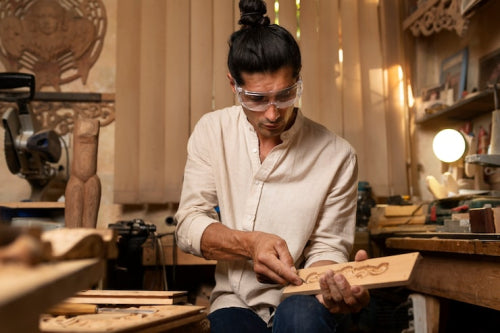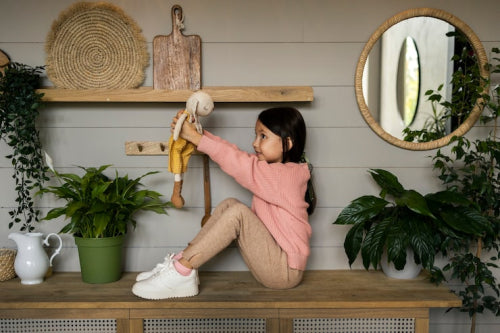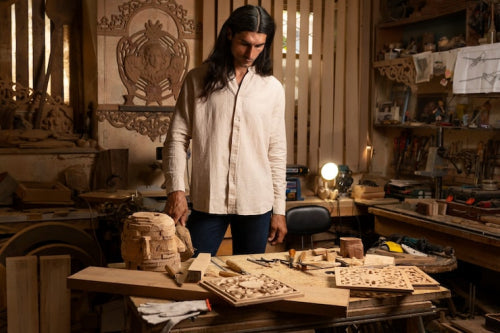In the vibrant chaos of Mumbai's Bandra West, where faded Art Deco facades meet gleaming glass towers, a tech entrepreneur stands amid half-unpacked boxes, contemplating her sun-drenched balcony. She rejects the cookie-cutter loungers from big-box stores, opting instead for a custom cane daybed that weaves in subtle Mughal arches, built from weather-resistant acacia to endure the monsoon downpours. This scene captures the pulse of India's evolving luxury furniture landscape, where personalization transforms homes into extensions of identity. Across metros like Bangalore's Silicon Valley buzz and Jaipur's artisanal alleys, affluent urbanites demand pieces that blend heritage with high-tech flair, fueling a market that's as dynamic as the cities themselves.
Mass-market furniture lacks heart, filling rooms with bland, short-lived pieces. Frequent breakdowns spark frustration, as replacements erode style and sentiment. At MMC Wood Creations, Udaipur artisans shape heirloom furniture with enduring craftsmanship and cozy elegance, creating pieces that echo your identity, ensuring your home radiates warmth and timeless connection. Shop Now!
The Evolution of Customization in Luxury Furniture
Once the domain of European ateliers shipping monolithic heirlooms to India's elite, luxury furniture has undergone a profound metamorphosis. Now, in the sweltering heat of Chennai's Marina Beach apartments or the cool heights of Pune's hillside villas, buyers dictate every curve and contour. This pivot stems from a confluence of forces: skyrocketing disposable incomes in tier-one cities, a youth bulge craving self-expression, and the e-commerce boom that democratizes design consultations. What was once an indulgence for the superrich has become attainable for the burgeoning upper-middle class, who view their abodes not as shelters but as canvases.
Examine the trajectory through hard data. The India furniture market stands at USD 29.97 billion in 2025, on track to expand to USD 43.24 billion by 2030 at a compound annual growth rate of 7.6 percent. Within this expanse, the premium tier accelerates even faster, with an 8 percent CAGR through 2030, as urban professionals in Hyderabad and Kolkata seek bespoke finishes like hand-inlaid dovetails and limited-edition weaves. Globally, customization amplifies this surge; the customized furniture sector, valued at USD 40.72 billion in 2024, climbs to USD 45.43 billion in 2025 and surges past USD 108.98 billion by 2033, propelled by a 11.56 percent CAGR. Consumers increasingly tailor modular wardrobes to ergonomic ideals or seating that aligns with lifestyle rhythms, a demand echoing India's home renovation frenzy, which topped USD 286.85 billion last year.
This evolution thrives on accessibility meeting aspiration. In Ahmedabad's bustling pols, middle-class families commission timeless wooden consoles that evoke ancestral havelis without the prohibitive price tag. Brands innovate by merging age-old craftsmanship think Jaipur's blue pottery accents with digital tools, yielding durable designs that outlast fads. The result? Furniture that doesn't just furnish but fortifies personal narratives, making luxury feel intimate rather than imposing.
Emerging Trends in Customization for Luxury Furniture
Step into a Bangalore design lab, and the air hums with possibility: holographic projections spin virtual prototypes of outdoor teak pavilions, refined via client feedback in real time. Technology anchors this renaissance computer-aided design software slashes iteration cycles from months to days, while additive manufacturing crafts intricate joints unfeasible by hand alone. These tools empower artisans to deliver precision without sacrificing soul, turning abstract visions into tangible realities for Pune's condo dwellers.
Sustainability emerges as the era's moral compass, intertwining ethics with elegance. Amid Delhi's smog-choked skies and Mumbai's coastal swells, eco-conscious buyers favor reclaimed hardwoods and bio-based finishes, shunning the environmental toll of mass production. In Kolkata's verdant parkside flats, custom pieces incorporate upcycled jute weaves, harmonizing with the city's literary ethos of mindful living. This green imperative drives the India luxury furniture market, forecasted to grow from USD 1.71 billion in 2024 to USD 2.37 billion by 2030 at a 5.6 percent CAGR from 2025 onward, as urbanites prioritize pieces that sustain both style and planet.
Local artistry infuses these trends with regional resonance. Chennai's master carpenters draw from Chettinad motifs for bespoke cabinets, embedding bronze filigree that withstands tropical humidity. In Jaipur, block-printed textiles drape over custom frames, while Hyderabad's weavers collaborate on cane accents for modern minimalism. Cultural nuances dictate flavors: Ahmedabad's geometric precision yields space-efficient steel-and-wood hybrids, contrasting Kolkata's baroque flourishes in rosewood etageres. These convergences spawn innovations, like monsoon-proof Bangalore loungers fusing Nordic restraint with Rajasthani latticework, ideal for al fresco evenings under drizzling skies.
Social platforms catalyze the fervor, with Instagram reels showcasing #BespokeHomes from Mumbai makeup moguls to Pune vinyl enthusiasts. This digital showcase propels the India luxury segment, estimated at USD 4.35 billion in 2024 and reaching USD 5.35 billion by 2029 via a 4.24 percent CAGR, buoyed by e-commerce's personalization prowess and urbanization's appetite for unique luxuries.
Real-World Examples & Applications of Custom Furniture
Pune's IT-fueled ascent manifests in skyline-defining towers, where interiors pulse with tailored ingenuity. Envision a Hinjewadi executive's multifunctional library: contoured shelves for rare editions, integrated task lighting mimicking natural glow, all in FSC-sourced sheesham that defies seasonal shifts. Delivered in under two months by local guilds versed in precision engineering, such commissions underscore Pune's bespoke surge, aligning with the national furniture wave's 7.6 percent trajectory.
Mumbai's hospitality vanguard elevates transience to artistry. In a Colaba boutique haven, guest sanctuaries feature headboards laser-etched with Parsi motifs, paired with concealed vanities boasting smart mirrors. These elements, forged in hybrid workshops melding automation with manual finesse, craft immersive tales. India's hotel pipeline over 1,000 openings by 2027 amplifies this, outpacing even North America's 4.3 percent luxury commercial growth.
Chennai reinterprets legacy through contemporary lenses. A Chepauk manor revival sports four-posters with Tanjore-inspired inlays, augmented by antimicrobial fabrics for allergy-prone heirs. Chettinad-trained smiths balance antiquity with adaptation, ensuring generational resilience. This embodies South India's vigor, where premium demands grow at 8 percent annually, per market analyses.
Amidst these narratives, emerging voices like MMC Wood Creations carve niches with affordable, enduring offerings in cane, wood, and outdoor realms classics that defy trends, from Hyderabad's veranda swings to Bangalore's veranda vanities. As a nascent player, they counter skepticism with unyielding quality, proving innovation trumps tenure in this democratized domain.
Key Challenges in Customizing Luxury Furniture
Bespoke brilliance demands navigating thorny thickets. Procuring elite teak for Jaipur's arid workshops? A supply chain ballet inflated 20 to 30 percent by geopolitical ripples. Timelines elongate what sparks as a hasty ideation extends into quarters, clashing with the instant gratification of scrollable showrooms.
Expectations clash with realities: A Kolkata visionary's latticed partition falters under structural scrutiny, necessitating trade-offs in heft or hardware. For fledgling brands, the specter of inexperience looms, yet candor detailing the craftsman's ledger metamorphoses barriers into bonds, preserving vision sans illusion.
Opportunities and Business Impact of Customization in Luxury Furniture
These obstacles, reframed, reveal reservoirs of potential. Mumbai's vertical sprawl births demand for executive suite's singular desks; Kolkata's revivalist wave summons gallery thrones. The national furniture vista balloons to USD 43.24 billion by 2030, with bespoke commanding 15 to 25 percent uplifts in yields.
Clientele crystallizes into advocates: An inaugural bench begets enduring patronage, etched in collaborative blueprints. Fabrication flourishes via numerical controls curbing excess, enabling Ahmedabad micro-enterprises to amplify without anarchy. For MMC Wood Creations, cane mastery captures Pune's patio patrons, alchemizing novelty nerves into vanguard acclaim.
Worldwide, tailored tides crest at USD 108.98 billion by 2033, a 11.56 percent dash from 2025's USD 45.43 billion, as platforms like Etsy India normalize niche narratives. In Bharat, it's visceral: Citizens curate existences, not acquire artifacts.
The Future of Customization in the Luxury Furniture Market
Gazing forward, visionaries at forums like Furnitech envision symbiotic textiles and virtual rehearsals, auditioning credenzas in augmented environs. Green edicts intensify, targeting 80 percent verdant premiums by 2030. India spearheads: Jaipur collectives digitize motifs, Chennai legacies globalize via algorithms.
Ascendant enterprises heed the manifesto: Fuse innovation with inheritance, pursue planetary harmony, attune to patron's murmurs. From Ahmedabad's arid expanses to Hyderabad's humid horizons, this synthesis transcends decoration, scripting destinies. As a Bandra artisan muses amid steaming brews, "Bespoke binds not merely rooms, but roots." Within that tapestry, entities like MMC Wood Creations embed eternally, stitch by steadfast stitch.
Frequently Asked Questions
What are the main challenges of ordering custom luxury furniture?
The primary challenges include complex supply chains that can inflate costs by 20-30% due to sourcing premium materials like elite teak, extended timelines that can stretch from initial concept to delivery over several months, and managing expectations when structural requirements clash with design visions. Additionally, customers must navigate trade-offs between aesthetic desires and practical considerations like weight, hardware limitations, and budget constraints, especially when working with emerging brands that may lack extensive experience.
What is driving the growth of customized luxury furniture in India?
The customized luxury furniture market in India is booming due to rising disposable incomes in tier-one cities, a youth demographic seeking self-expression, and the e-commerce revolution that has democratized design consultations. The India furniture market is projected to grow from USD 29.97 billion in 2025 to USD 43.24 billion by 2030, with the premium segment accelerating even faster at 8% CAGR as urban professionals demand bespoke finishes and personalized designs.
How does technology impact custom furniture design and manufacturing?
Modern technology has revolutionized custom furniture through computer-aided design software that reduces iteration cycles from months to days, and additive manufacturing that creates intricate joints impossible to craft by hand. Design labs now use holographic projections and virtual prototypes for real-time client feedback, while numerical controls help reduce waste and enable precision manufacturing. This technological integration allows artisans to deliver precision without sacrificing the soul of handcrafted pieces.
Disclaimer: The above helpful resources content contains personal opinions and experiences. The information provided is for general knowledge and does not constitute professional advice.
You may also be interested in: Storage
Mass-market furniture lacks heart, filling rooms with bland, short-lived pieces. Frequent breakdowns spark frustration, as replacements erode style and sentiment. At MMC Wood Creations, Udaipur artisans shape heirloom furniture with enduring craftsmanship and cozy elegance, creating pieces that echo your identity, ensuring your home radiates warmth and timeless connection. Shop Now!
Powered by flareAI.co




